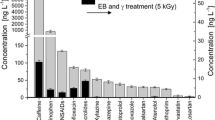Abstract
Handling genotoxic compounds commonly used in cancer chemotherapy generates contaminated wastes that require decontamination before disposal. Chemical methods are an alternative and/or a complement to incineration for the treatment of wastes and spills. As part of a program initiated by the International Agency for Research on Cancer (IARC), three chemical methods readily available in the hospital environment, viz sodium hypochlorite (NaOCl, 5.25%), hydrogen peroxide (H2O2,?30%) and Fenton reagent (FeCl2, 2H2O; 0.3 g in 10 ml H2O2, 30%), were tested for the degradation of three alkylating agents (cyclophosphamide, CP; ifosfamide, IF, and melphalan). Pharmaceutical preparations corresponding to the most highly concentrated administration solutions in either NaCl (0.9%) or dextrose (5%) were inactivated by oxidation volume/volume with each of the methods for at least 1 h. The efficiency of degradation was monitored by high-pressure liquid chromatography. The mutagenicity of the degradation residues was tested by means of the Ames test using tester strains of Salmonella typhimurium TA 97a, TA 98, TA 100 and TA 102 with and without an exogenous metabolic activation system. Complete disappearance of CP was observed after 1 h with all degradation methods. However, direct mutagens were generated by the Fenton oxidation technique in the presence of dextrose (5%). IF was completely degraded by the Fenton reagent and NaOCl methods. No mutagenic residues were detected after 1 h of treatment with the Fenton technique, and after 3 h with the NaOCl method. Direct-acting mutagens remained after the H2O2 treatment in the presence of dextrose (5%). Complete degradation of melphalan was achieved in 1 h by each of the three methods, and no mutagenic residues were produced by any of the treatments. The use of NaOCl (5.25%) proved the most efficient system for degradation of the three alkylating agents.
Similar content being viewed by others
Author information
Authors and Affiliations
Additional information
Received: 28 November 1995/Accepted: 2 April 1996
Rights and permissions
About this article
Cite this article
Hansel, S., Castegnaro, M., Sportouch, M. et al. Chemical degradation of wastes of antineoplastic agents: cyclophosphamide, ifosfamide and melphalan. Int Arch Occup Environ Health 69, 109–114 (1996). https://doi.org/10.1007/s004200050124
Issue Date:
DOI: https://doi.org/10.1007/s004200050124



